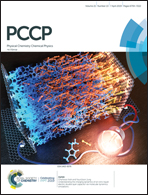Tuning the work function of the silicene/4 × 4 Ag(111) surface†
Abstract
Silicene, the silicon analog of graphene, is an atomically thin two-dimensional material with promising applications in gas sensing, storage and as components in modern electronic devices. Silicene epitaxially grown on the Ag(111) surface can expand the utility of the silver surface by enabling the tuning of its work function through the functionalisation of silicene. Here we examine the electronic and structural properties and the thermodynamic stability of functionalised silicene/4 × 4 Ag(111) using density functional theory calculations coupled with ab initio molecular dynamics (AIMD) simulations. We focus on 11 functional groups, namely phenyl, methyl, hydroxyl, cyano, methoxyl, amino and ethylmethylamine, in addition to 4 halogen atoms. These functional groups are shown to endow the Si/Ag(111) surface with a large variation in the work function. Our AIMD simulations confirm the thermodynamic stability of these 11 functionalised structures. This work shows the possibility of tuning the electronic structure of silicene by functionalisation, which could then be utilized in polymer solar cells and nanoelectronic circuit components.



 Please wait while we load your content...
Please wait while we load your content...